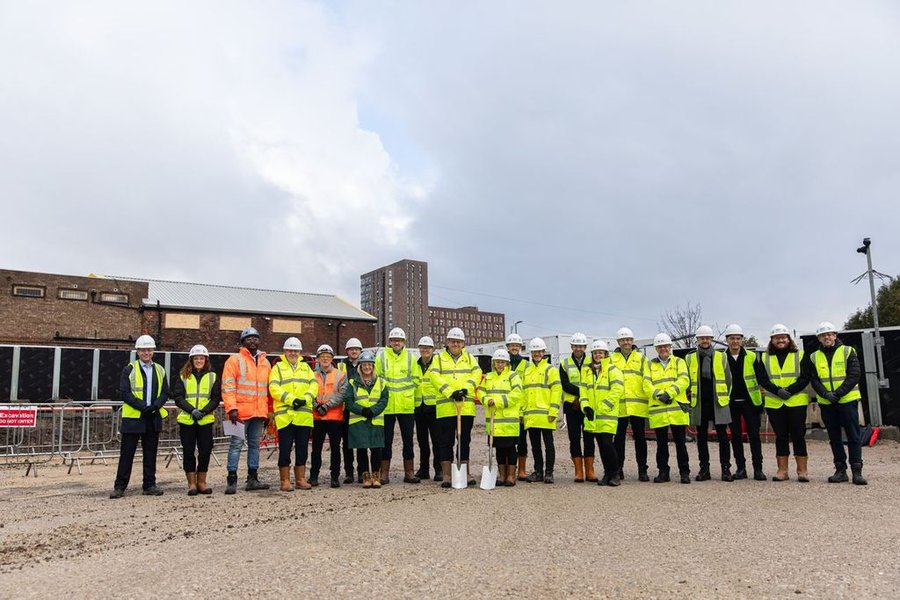Morgan Sindall Construction has begun work on a brand-new acoustics research, testing and teaching facility for the University of Salford.
For over 60 years the teams at Salford have shaped how we hear the world, from leading pioneering research projects and setting industry and government standards to influencing the sound of products sold worldwide.
The new acoustics institute will see a step change in the innovation and development which the University of Salford can offer, enabling forensic precision engineering on everything from AI-enabled hearing aids which will make music sound better, to the noise that heat pumps create.

It will sit within Crescent Innovation, which forms part of the wider £2.5bn Crescent Salford masterplan being delivered by the Crescent Partnership. This comprises the University of Salford, Salford City Council and ECF – a joint partnership between Homes England, L&G and Muse.
The building has also received funding from the GMCA (Greater Manchester Combined Authority) through the Greater Manchester Industrial Strategy Zone. The Crescent Salford regeneration is a key project within Greater Manchester’s Central Growth Cluster – one of the city region’s six Growth Locations, where investment is being targeted to turbocharge growth.
Costing nearly £24m, the new state-of-the-art building will feature vibration-isolating foundations and walls constructed from extra dense concrete to insulate the space from external noise and create several idealised acoustic environments. Completion is scheduled for mid 2027.
The building will be centred around a vast triple-height space housing a suite of acoustically isolated laboratories. These include anechoic chambers and a wind tunnel, a four chamber Building Environment Testing Suite to measure modern construction materials to ensure future living & working spaces are protected from external noise and a perception engineering sleep laboratory to understand how people respond to sound from conversations in noisy restaurants to aircraft waking you up at night.
It will house some of the quietest rooms in the world, designed to meet international standards for ultra precise measurements. For example, this could be the hum of a breast pump or the sound of an insect crawling across the floor.
For testing at the opposite end of the scale, an overhead crane system will ensure the most heavy-duty projects can also be put through their paces acoustically. The design will provide the perfect environment for testing the noise of anything from electric vehicles and aeroplane engines to loudspeaker stacks and emergency workers’ communications systems.
![North_On[1]](https://morgan-sindall-pztazn5y-media.s3.amazonaws.com/construction/images/North_On1.min-800x600.jpg)
![Flat_On[1]](https://morgan-sindall-pztazn5y-media.s3.amazonaws.com/construction/images/Flat_On1.min-800x600.jpg)
![South_On[1]](https://morgan-sindall-pztazn5y-media.s3.amazonaws.com/construction/images/South_On1.min-800x600.jpg)
The acoustics building represents the latest collaboration between the university and Morgan Sindall, with the contractor having also delivered the Science, Engineering and Environment Building (SEE Building) and the North of England Robotics Innovation Centre (NERIC) on the campus in recent years.
Steven Gregory, North West area director, Morgan Sindall Construction, said:
Our relationship with the University of Salford is built on shared values of innovation, quality and sustainability. This new acoustics building will be a true testament to those principles - a space designed with exceptional precision to support world-leading research. Using our Intelligent Solutions approach, we’re ensuring the facility meets the highest standards of performance, while delivering lasting benefits for the Salford community.”
Throughout the build programme Morgan Sindall will deploy its Intelligent Solutions approach, which brings together digital and platform design capabilities with modern construction methods and innovative carbon reduction tools to create unique, sustainable, and inspiring places for its clients.
Morgan Sindall will ensure the project delivers real, lasting benefits for the Salford community through a dedicated social value plan. Building on the strong local connections and partnerships developed during earlier projects, the team will continue to create opportunities for local employment, skills development, and engagement with both university students and the wider Salford community.
Professor of Acoustics at the University of Salford, Trevor Cox, said:
It is great to see our new building under construction. This is a very exciting time for acoustics at Salford as acoustics research is becoming increasingly relevant to society today. The World Health Organisation recently labelled noise the second most harmful environmental pollutant, and new technologies such as drones, AI and EVs are changing everyday sounds in our world.
The new acoustics building at Salford will allow us to strengthen our support for business of all sizes, as we work with product sound engineers on the innovations which will drive productivity and efficiency. It will also be used by our PhDs in our EPSRC Centre for Doctoral Training in Sustainable Sound Futures, which is now recruiting for 2026.”
The new building is part of the University of Salford’s multi-million pound Campus Connectivity Plan, which is the most ambitious redevelopment of its research, teaching and public spaces that the University has ever undertaken.
In line with the latest sustainability standards, the new all-electric Acoustics Building will target as a minimum a BREEAM rating of ‘Excellent’, and utilise low-energy and low-carbon technologies to minimise energy consumption and reduce the carbon footprint of the building.
Max Bentham, development director at ECF, said:
Work starting on the state-of-the-art acoustics building marks another key milestone in the creation of Crescent Innovation. Designed to bring industry and education together, Crescent Innovation will provide 1.7m sq. ft of new commercial, academic and research floorspace to attract investment, create jobs and give local residents, students and businesses the tools to reach their full potential, putting Salford firmly on the map as a city built for the future.
The acoustics facility will build on Salford’s existing expertise in this area, fostering research and innovation that will have a global impact.”
ENDS


![North_On[1]](https://morgan-sindall-pztazn5y-media.s3.amazonaws.com/construction/images/North_On1.width-1600.jpg)